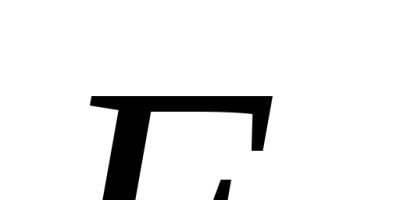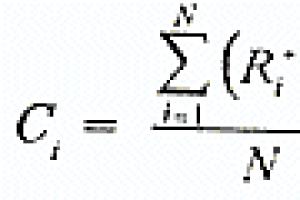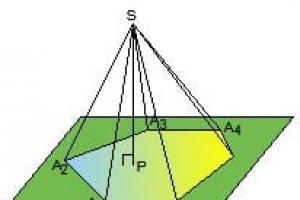How to build a parabola? There are several ways to graph a quadratic function. Each of them has its pros and cons. Let's consider two ways.
Let's start by plotting a quadratic function of the form y=x²+bx+c and y= -x²+bx+c.
Example.
Graph the function y=x²+2x-3.
Solution:
y=x²+2x-3 is a quadratic function. The graph is a parabola with branches up. Parabola vertex coordinates
![]()
From the vertex (-1;-4) we build a graph of the parabola y=x² (as from the origin of coordinates. Instead of (0;0) - vertex (-1;-4). From (-1;-4) we go to the right by 1 unit and up by 1 unit, then left by 1 and up by 1; further: 2 - right, 4 - up, 2 - left, 4 - up; 3 - right, 9 - up, 3 - left, 9 - up. If these 7 points are not enough, then 4 to the right, 16 to the top, etc.).

The graph of the quadratic function y= -x²+bx+c is a parabola, the branches of which are directed downward. To construct a graph, we look for the coordinates of the vertex and from it we construct a parabola y= -x².
Example.
Graph the function y= -x²+2x+8.
Solution:
y= -x²+2x+8 is a quadratic function. The graph is a parabola with branches down. Parabola vertex coordinates
![]()
From the top we build a parabola y= -x² (1 - to the right, 1- down; 1 - left, 1 - down; 2 - right, 4 - down; 2 - left, 4 - down, etc.):

This method allows you to build a parabola quickly and does not cause difficulties if you know how to graph the functions y=x² and y= -x². Disadvantage: if the coordinates of the vertex are fractional numbers, it is not very convenient to build a graph. If you need to know the exact values of the points of intersection of the graph with the Ox axis, you will have to additionally solve the equation x²+bx+c=0 (or -x²+bx+c=0), even if these points can be directly determined from the drawing.
Another way to construct a parabola is by points, that is, you can find several points on the graph and draw a parabola through them (taking into account that the line x=xₒ is its axis of symmetry). Usually for this they take the vertex of the parabola, the points of intersection of the graph with the coordinate axes and 1-2 additional points.
Draw a graph of the function y=x²+5x+4.
Solution:
y=x²+5x+4 is a quadratic function. The graph is a parabola with branches up. Parabola vertex coordinates
![]()
that is, the vertex of the parabola is the point (-2.5; -2.25).
Are looking for . At the point of intersection with the Ox axis y=0: x²+5x+4=0. The roots of the quadratic equation x1=-1, x2=-4, that is, we got two points on the graph (-1; 0) and (-4; 0).
At the point of intersection of the graph with the Oy axis x=0: y=0²+5∙0+4=4. We got the point (0; 4).
To clarify the graph, you can find an additional point. Let's take x=1, then y=1²+5∙1+4=10, that is, another point on the graph is (1; 10). We mark these points on the coordinate plane. Taking into account the symmetry of the parabola relative to the straight line passing through its vertex, we mark two more points: (-5; 6) and (-6; 10) and draw a parabola through them:

Graph the function y= -x²-3x.
Solution:
y= -x²-3x is a quadratic function. The graph is a parabola with branches down. Parabola vertex coordinates
![]()
The vertex (-1.5; 2.25) is the first point of the parabola.
At the points of intersection of the graph with the x-axis y=0, that is, we solve the equation -x²-3x=0. Its roots are x=0 and x=-3, that is (0;0) and (-3;0) - two more points on the graph. The point (o; 0) is also the point of intersection of the parabola with the ordinate axis.
At x=1 y=-1²-3∙1=-4, that is (1; -4) is an additional point for plotting.

Constructing a parabola from points is a more labor-intensive method compared to the first one. If the parabola does not intersect the Ox axis, more additional points will be required.
Before continuing to construct graphs of quadratic functions of the form y=ax²+bx+c, let us consider the construction of graphs of functions using geometric transformations. It is also most convenient to construct graphs of functions of the form y=x²+c using one of these transformations—parallel translation.
Category: |A function of the form where is called quadratic function.
Graph of a quadratic function – parabola.

Let's consider the cases:
I CASE, CLASSICAL PARABOLA
That is , ,
To construct, fill out the table by substituting the x values into the formula:

Mark the points (0;0); (1;1); (-1;1), etc. on the coordinate plane (the smaller the step we take the x values (in this case, step 1), and the more x values we take, the smoother the curve will be), we get a parabola:

It is easy to see that if we take the case , , , that is, then we get a parabola that is symmetrical about the axis (oh). It’s easy to verify this by filling out a similar table:

II CASE, “a” IS DIFFERENT FROM UNIT
What will happen if we take , , ? How will the behavior of the parabola change? With title="Rendered by QuickLaTeX.com" height="20" width="55" style="vertical-align: -5px;"> парабола изменит форму, она “похудеет” по сравнению с параболой (не верите – заполните соответствующую таблицу – и убедитесь сами):!}

In the first picture (see above) it is clearly visible that the points from the table for the parabola (1;1), (-1;1) were transformed into points (1;4), (1;-4), that is, with the same values, the ordinate of each point is multiplied by 4. This will happen to all key points of the original table. We reason similarly in the cases of pictures 2 and 3.
And when the parabola “becomes wider” than the parabola:

Let's summarize:
1)The sign of the coefficient determines the direction of the branches. With title="Rendered by QuickLaTeX.com" height="14" width="47" style="vertical-align: 0px;"> ветви направлены вверх, при - вниз. !}
2) Absolute value coefficient (modulus) is responsible for the “expansion” and “compression” of the parabola. The larger , the narrower the parabola; the smaller |a|, the wider the parabola.
III CASE, “C” APPEARS
Now let's introduce into the game (that is, consider the case when), we will consider parabolas of the form . It is not difficult to guess (you can always refer to the table) that the parabola will shift up or down along the axis depending on the sign:

IV CASE, “b” APPEARS
When will the parabola “break away” from the axis and finally “walk” along the entire coordinate plane? When will it stop being equal?
Here to construct a parabola we need formula for calculating the vertex: , .
So at this point (as at the point (0;0) of the new coordinate system) we will build a parabola, which we can already do. If we are dealing with the case, then from the vertex we put one unit segment to the right, one up, - the resulting point is ours (similarly, a step to the left, a step up is our point); if we are dealing with, for example, then from the vertex we put one unit segment to the right, two - upward, etc.
For example, the vertex of a parabola:
Now the main thing to understand is that at this vertex we will build a parabola according to the parabola pattern, because in our case.

When constructing a parabola after finding the coordinates of the vertex veryIt is convenient to consider the following points:
1) parabola will definitely pass through the point . Indeed, substituting x=0 into the formula, we obtain that . That is, the ordinate of the point of intersection of the parabola with the axis (oy) is . In our example (above), the parabola intersects the ordinate at point , since .
2) axis of symmetry parabolas is a straight line, so all points of the parabola will be symmetrical about it. In our example, we immediately take the point (0; -2) and build it symmetrical relative to the symmetry axis of the parabola, we get the point (4; -2) through which the parabola will pass.
3) Equating to , we find out the points of intersection of the parabola with the axis (oh). To do this, we solve the equation. Depending on the discriminant, we will get one (, ), two ( title="Rendered by QuickLaTeX.com" height="14" width="54" style="vertical-align: 0px;">, ) или нИсколько () точек пересечения с осью (ох) !} . In the previous example, our root of the discriminant is not an integer; when constructing, it doesn’t make much sense for us to find the roots, but we clearly see that we will have two points of intersection with the axis (oh) (since title="Rendered by QuickLaTeX.com" height="14" width="54" style="vertical-align: 0px;">), хотя, в общем, это видно и без дискриминанта.!}
So let's work it out
Algorithm for constructing a parabola if it is given in the form
1) determine the direction of the branches (a>0 – up, a<0 – вниз)
2) we find the coordinates of the vertex of the parabola using the formula , .
3) we find the point of intersection of the parabola with the axis (oy) using the free term, construct a point symmetrical to this point with respect to the symmetry axis of the parabola (it should be noted that it happens that it is unprofitable to mark this point, for example, because the value is large... we skip this point...)
4) At the found point - the vertex of the parabola (as at the point (0;0) of the new coordinate system) we construct a parabola. If title="Rendered by QuickLaTeX.com" height="20" width="55" style="vertical-align: -5px;">, то парабола становится у’же по сравнению с , если , то парабола расширяется по сравнению с !}
5) We find the points of intersection of the parabola with the axis (oy) (if they have not yet “surfaced”) by solving the equation
Example 1

Example 2

Note 1. If the parabola is initially given to us in the form , where are some numbers (for example, ), then it will be even easier to construct it, because we have already been given the coordinates of the vertex . Why?
Let's take a quadratic trinomial and isolate the complete square in it: Look, we got that , . You and I previously called the vertex of a parabola, that is, now,.
For example, . We mark the vertex of the parabola on the plane, we understand that the branches are directed downward, the parabola is expanded (relative to ). That is, we carry out points 1; 3; 4; 5 from the algorithm for constructing a parabola (see above).

Note 2. If the parabola is given in a form similar to this (that is, presented as a product of two linear factors), then we immediately see the points of intersection of the parabola with the axis (ox). In this case – (0;0) and (4;0). For the rest, we act according to the algorithm, opening the brackets.
Constructing a parabola is one of the well-known mathematical operations. Quite often it is used not only for scientific purposes, but also for purely practical ones. Let's find out how to perform this procedure using the Excel application tools.
A parabola is the graph of a quadratic function of the following type f(x)=ax^2+bx+c. One of its remarkable properties is the fact that a parabola has the form of a symmetrical figure consisting of a set of points equidistant from the directrix. By and large, constructing a parabola in Excel is not much different from constructing any other graph in this program.
Creating a table
First of all, before you start building a parabola, you should build a table on the basis of which it will be created. For example, let's take the construction of a graph of a function f(x)=2x^2+7.


Plotting a graph
As mentioned above, now we have to build the graph itself.


Editing a chart
Now you can slightly edit the resulting graph.


In addition, you can perform any other types of editing of the resulting parabola, including changing its name and the names of the axes. These editing techniques do not go beyond the scope of working in Excel with other types of diagrams.
As you can see, constructing a parabola in Excel is no fundamentally different from constructing another type of graph or diagram in the same program. All actions are performed on the basis of a pre-generated table. In addition, you need to take into account that the scatter diagram is most suitable for constructing a parabola.
I suggest that the rest of the readers significantly expand their school knowledge about parabolas and hyperbolas. Hyperbola and parabola - are they simple? ...Can't wait =)
Hyperbola and its canonical equation
The general structure of the presentation of the material will resemble the previous paragraph. Let's start with the general concept of a hyperbola and the task of constructing it.
The canonical equation of a hyperbola has the form , where are positive real numbers. Please note that, unlike ellipse, the condition is not imposed here, that is, the value of “a” may be less than the value of “be”.
I must say, quite unexpectedly... the equation of the “school” hyperbola does not even closely resemble the canonical notation. But this mystery will still have to wait for us, but for now let’s scratch our heads and remember what characteristic features the curve in question has? Let's spread it on the screen of our imagination graph of a function ….
A hyperbola has two symmetrical branches.
Not bad progress! Any hyperbole has these properties, and now we will look with genuine admiration at the neckline of this line:
Example 4
Construct the hyperbola given by the equation
Solution: in the first step, we bring this equation to canonical form. Please remember the standard procedure. On the right you need to get “one”, so we divide both sides of the original equation by 20: 
Here you can reduce both fractions, but it is more optimal to do each of them three-story:
And only after that carry out the reduction:
Select the squares in the denominators:
Why is it better to carry out transformations this way? After all, the fractions on the left side can be immediately reduced and obtained. The fact is that in the example under consideration we were a little lucky: the number 20 is divisible by both 4 and 5. In the general case, such a number does not work. Consider, for example, the equation . Here with divisibility everything is sadder and without three-story fractions no longer possible: 
So, let's use the fruit of our labors - the canonical equation:
How to construct a hyperbola?
There are two approaches to constructing a hyperbola - geometric and algebraic.
From a practical point of view, drawing with a compass... I would even say utopian, so it is much more profitable to once again use simple calculations to help.
It is advisable to adhere to the following algorithm, first the finished drawing, then the comments:

In practice, a combination of rotation by an arbitrary angle and parallel translation of the hyperbola is often encountered. This situation is discussed in class Reducing the 2nd order line equation to canonical form.
Parabola and its canonical equation
It's finished! She's the one. Ready to reveal many secrets. The canonical equation of a parabola has the form , where is a real number. It is easy to notice that in its standard position the parabola “lies on its side” and its vertex is at the origin. In this case, the function specifies the upper branch of this line, and the function – the lower branch. It is obvious that the parabola is symmetrical about the axis. Actually, why bother:
Example 6
Construct a parabola
Solution: the vertex is known, let’s find additional points. The equation ![]() determines the upper arc of the parabola, the equation determines the lower arc.
determines the upper arc of the parabola, the equation determines the lower arc.
In order to shorten the recording of the calculations, we will carry out the calculations “with one brush”: 
For compact recording, the results could be summarized in a table.
Before performing an elementary point-by-point drawing, let’s formulate a strict
definition of parabola:
A parabola is the set of all points in the plane that are equidistant from a given point and a given line that does not pass through the point.
The point is called focus parabolas, straight line - headmistress (spelled with one "es") parabolas. The constant "pe" of the canonical equation is called focal parameter, which is equal to the distance from the focus to the directrix. In this case . In this case, the focus has coordinates , and the directrix is given by the equation .
In our example: 
The definition of a parabola is even simpler to understand than the definitions of an ellipse and a hyperbola. For any point on a parabola, the length of the segment (the distance from the focus to the point) is equal to the length of the perpendicular (the distance from the point to the directrix):
Congratulations! Many of you have made a real discovery today. It turns out that a hyperbola and a parabola are not graphs of “ordinary” functions at all, but have a pronounced geometric origin.
Obviously, as the focal parameter increases, the branches of the graph will “raise” up and down, approaching infinitely close to the axis. As the “pe” value decreases, they will begin to compress and stretch along the axis
The eccentricity of any parabola is equal to unity:
Rotation and parallel translation of a parabola
The parabola is one of the most common lines in mathematics, and you will have to build it really often. Therefore, please pay special attention to the final paragraph of the lesson, where I will discuss typical options for the location of this curve.
! Note : as in the cases with previous curves, it is more correct to talk about rotation and parallel translation of coordinate axes, but the author will limit himself to a simplified version of the presentation so that the reader has a basic understanding of these transformations.
Maintaining your privacy is important to us. For this reason, we have developed a Privacy Policy that describes how we use and store your information. Please review our privacy practices and let us know if you have any questions.
Collection and use of personal information
Personal information refers to data that can be used to identify or contact a specific person.
You may be asked to provide your personal information at any time when you contact us.
Below are some examples of the types of personal information we may collect and how we may use such information.
What personal information do we collect:
- When you submit an application on the site, we may collect various information, including your name, telephone number, email address, etc.
How we use your personal information:
- The personal information we collect allows us to contact you with unique offers, promotions and other events and upcoming events.
- From time to time, we may use your personal information to send important notices and communications.
- We may also use personal information for internal purposes, such as conducting audits, data analysis and various research in order to improve the services we provide and provide you with recommendations regarding our services.
- If you participate in a prize draw, contest or similar promotion, we may use the information you provide to administer such programs.
Disclosure of information to third parties
We do not disclose the information received from you to third parties.
Exceptions:
- If necessary - in accordance with the law, judicial procedure, in legal proceedings, and/or on the basis of public requests or requests from government bodies in the Russian Federation - to disclose your personal information. We may also disclose information about you if we determine that such disclosure is necessary or appropriate for security, law enforcement, or other public importance purposes.
- In the event of a reorganization, merger, or sale, we may transfer the personal information we collect to the applicable successor third party.
Protection of personal information
We take precautions - including administrative, technical and physical - to protect your personal information from loss, theft, and misuse, as well as unauthorized access, disclosure, alteration and destruction.
Respecting your privacy at the company level
To ensure that your personal information is secure, we communicate privacy and security standards to our employees and strictly enforce privacy practices.








